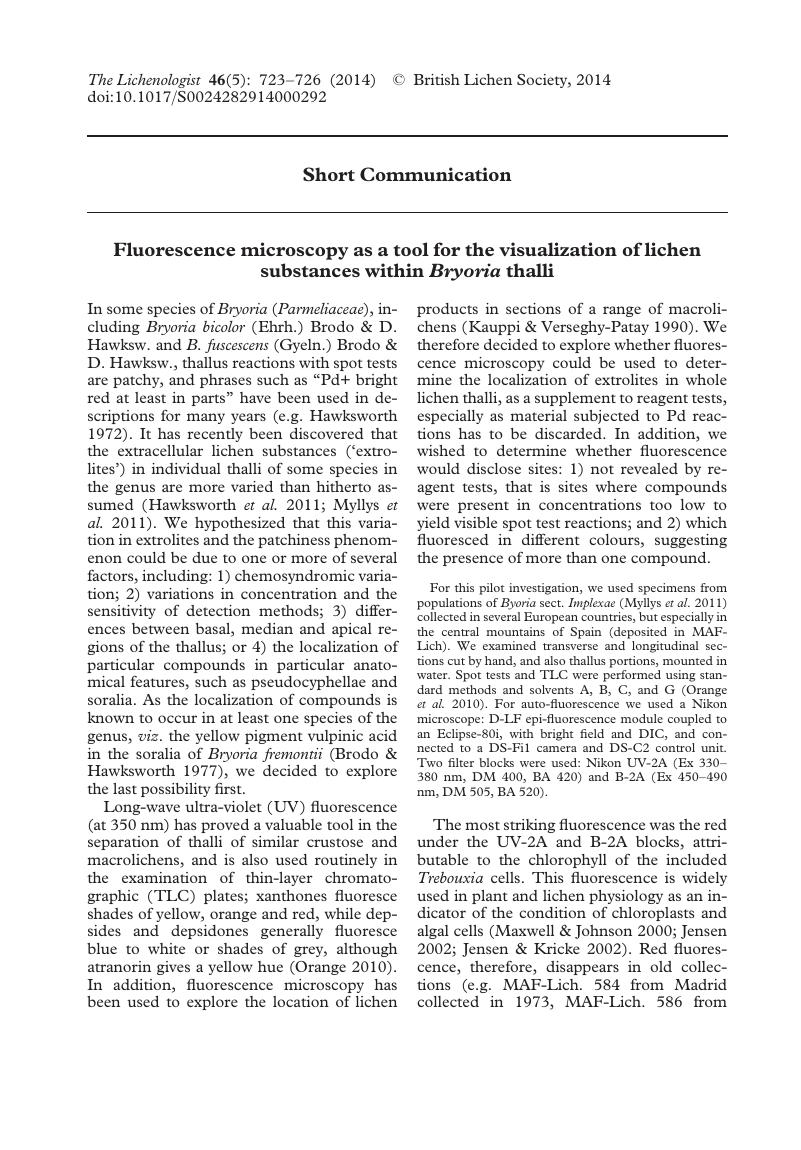Crossref Citations
This article has been cited by the following publications. This list is generated based on data provided by Crossref.
Boluda, Carlos G.
Rico, Víctor J.
Crespo, Ana
Divakar, Pradeep K.
and
Hawksworth, David L.
2015.
Molecular sequence data from populations of Bryoria fuscescens s. lat. in the mountains of central Spain indicates a mismatch between haplotypes and chemotypes.
The Lichenologist,
Vol. 47,
Issue. 5,
p.
279.
Le Pogam, Pierre
and
Boustie, Joël
2016.
Xanthones of Lichen Source: A 2016 Update.
Molecules,
Vol. 21,
Issue. 3,
p.
294.
Lendemer, James C.
2016.
Recent literature on lichens—240.
The Bryologist,
Vol. 119,
Issue. 1,
p.
107.
Barreiro Felpeto, Aldo
Śliwińska-Wilczewska, Sylwia
Złoch, Ilona
and
Vasconcelos, Vitor
2018.
Light-dependent cytolysis in the allelopathic interaction between picoplanktic and filamentous cyanobacteria.
Journal of Plankton Research,
Vol. 40,
Issue. 2,
p.
165.
Nakajima, Hiromitsu
Fujimoto, Naoki
Yamamoto, Yoshikazu
Amemiya, Takashi
and
Itoh, Kiminori
2019.
Effect of Cu on the fluorescence of the Cu-hyperaccumulator lichen Stereocaulon sorediiferum.
Environmental Science and Pollution Research,
Vol. 26,
Issue. 36,
p.
36754.
Boluda, Carlos G.
Rico, Víctor J.
Naciri, Yamama
Hawksworth, David L.
and
Scheidegger, Christoph
2021.
Phylogeographic reconstructions can be biased by ancestral shared alleles: The case of the polymorphic lichen Bryoria fuscescens in Europe and North Africa.
Molecular Ecology,
Vol. 30,
Issue. 19,
p.
4845.
Wiśniewska, Kinga
Śliwińska-Wilczewska, Sylwia
Savoie, Mireille
and
Lewandowska, Anita U.
2022.
Quantitative and qualitative variability of airborne cyanobacteria and microalgae and their toxins in the coastal zone of the Baltic Sea.
Science of The Total Environment,
Vol. 826,
Issue. ,
p.
154152.
Xu, Maonian
Oppong-Danquah, Ernest
Wang, Xiaoyu
Oddsson, Sebastian
Abdelrahman, Asmaa
Pedersen, Simon Vilms
Szomek, Maria
Gylfason, Aron Elvar
Snorradottir, Bergthora Sigridur
Christensen, Eva Arnspang
Tasdemir, Deniz
Jameson, Cynthia J.
Murad, Sohail
Andresson, Olafur Sigmar
Magnusson, Kristinn Petur
de Boer, Hugo J.
Thorsteinsdottir, Margret
Omarsdottir, Sesselja
Heidmarsson, Starri
and
Olafsdottir, Elin Soffia
2022.
Novel methods to characterise spatial distribution and enantiomeric composition of usnic acids in four Icelandic lichens.
Phytochemistry,
Vol. 200,
Issue. ,
p.
113210.
Wiśniewska, Kinga A.
Śliwińska-Wilczewska, Sylwia
and
Lewandowska, Anita U.
2022.
Airborne microalgal and cyanobacterial diversity and composition during rain events in the southern Baltic Sea region.
Scientific Reports,
Vol. 12,
Issue. 1,



